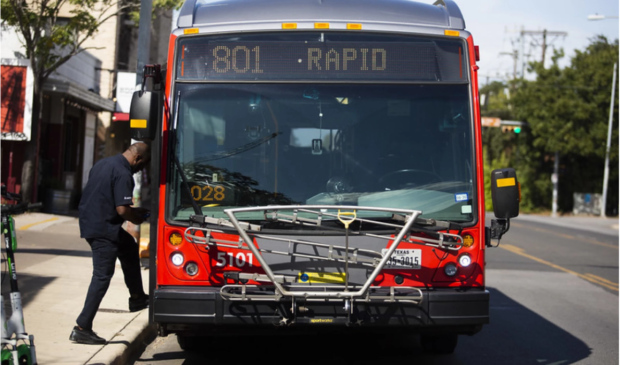Photo by Gabriel C. Pérez/KUT
Capital Metro seeks to make transit more accessible for low-income riders
Thursday, November 19, 2020 by
Samuel King Capital Metropolitan Transportation Authority is launching two new initiatives that aim to expand equity and access to its app. One will test capping fares for low-income users, while the other will allow those customers and others to pay for rides on the app even if they don’t have access to credit or debit cards.
Capping the Fares
At $1.25 per one-way local bus trip, Capital Metro’s base fare is among the lowest in the country compared to other transit agencies its size. But that doesn’t mean it’s always affordable to everyone. That’s especially true when it comes to buying monthly passes, which run $41.25. Seniors, active military personnel and those with disabilities are eligible for reduced-fare passes, but many lower-income riders don’t fall into those categories.
“They may be riding as many times as our customers that buy the period passes for riding, but (we know) they don’t participate in the discounts, because they pay every time they ride,” Reinet Marneweck, Capital Metro’s chief financial officer, said.
People who buy passes upfront are also eligible for discounts anywhere from 25 percent to 38 percent, so that means those who can afford to only pay for rides day to day are actually paying more in the long run. To change that, Capital Metro is launching a small pilot program to cap fares using its app.
“The customers will pay as they go, and they will only have to buy a single ride,” Marneweck said. “But when they reach the equivalent cost of a period pass, the fare is capped and they can ride for free the rest of the 31-day period.”
Capital Metro is hoping 200 people will take part in the pilot program at first. Riders will be able to participate if they can show they are enrolled in programs such as Medicaid, CHIP, TANF or Central Health’s MAP program.
Officials said they plan to reach out to groups like the Austin Urban League and Austin NAACP for help getting the word out.
Cash to Mobile
Austin NAACP President Nelson Linder said he’s pleased about another Capital Metro initiative launched last week. The cash-to-mobile program promises to provide wider access to contactless payments through the CapMetro app. People can go to one of more than 250 stores to load cash into their app accounts. Linder says the change will greatly help those without access to credit or debit cards.
“Not having a credit card and having cash should not be a barrier, and part of service is making sure that all your clientele, especially those who need it the most, have access,” Linder said. “So certainly we need to accommodate those concerns, because again, these are people who for the most part have a history of being exposed to inequity and lack of services.”
Advocates across the country have called for more transit agencies to go fare-free as a way of increasing equity. Capital Metro might seem like a candidate for that approach, as it receives only about 10 percent of its revenue from fares. Larger transit agencies like those in San Francisco and New York, meanwhile, draw much of their revenues from fares.
Marneweck said there are a lot of factors to consider before taking such an “aspirational” step.
“The biggest of which is the revenue loss and finding alternative revenue sources to fund that revenue,” she said. “And we will collect revenue in order to provide service.”
While Capital Metro officials have hinted that a fare increase will come in the near future, the agency’s most recent budget does not include one. Marneweck said the potential for an increase did not factor into its latest initiatives.
Linder said he’s not expecting Capital Metro to drop fares anytime soon, but he hopes the fare-capping program will expand regardless of what the agency decides to do.
“I think they can certainly make it applicable to the folks themselves based on their income levels,” he said. “And I think there is going to be a conversation surrounding that.”
Linder also hopes Capital Metro will increase its community outreach as Project Connect, the transit expansion plan, is built out. Some of the equity initiatives in the plan include $300 million in funding aimed at keeping people from being priced out of their neighborhoods once new transit lines are built.
Capital Metro plans to gather feedback about the pilot program over the next six months before determining what’s next.
This story was produced as part of the Austin Monitor’s reporting partnership with KUT.
The Austin Monitor’s work is made possible by donations from the community. Though our reporting covers donors from time to time, we are careful to keep business and editorial efforts separate while maintaining transparency. A complete list of donors is available here, and our code of ethics is explained here.
You're a community leader
And we’re honored you look to us for serious, in-depth news. You know a strong community needs local and dedicated watchdog reporting. We’re here for you and that won’t change. Now will you take the powerful next step and support our nonprofit news organization?











